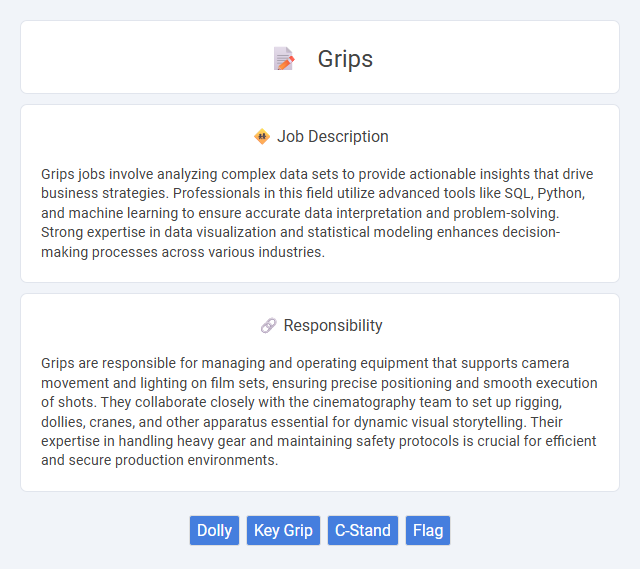
Grips jobs involve analyzing complex data sets to provide actionable insights that drive business strategies. Professionals in this field utilize advanced tools like SQL, Python, and machine learning to ensure accurate data interpretation and problem-solving. Strong expertise in data visualization and statistical modeling enhances decision-making processes across various industries.
Grips typically work in physically demanding environments, requiring individuals to have good strength, stamina, and coordination, which suggests that those with strong physical fitness are more likely to be suitable for this role. The job often involves teamwork and adapting to fast-paced, dynamic settings, so candidates with reliable communication skills and a collaborative mindset may have a higher probability of success. People who struggle with manual labor or find high-pressure work environments challenging might face difficulties in thriving within this profession.
Qualification
Grips job requires expertise in handling camera equipment, rigging, and lighting setups on film sets. Candidates must demonstrate strong technical skills, physical endurance, and knowledge of safety protocols. Experience with grip tools, understanding of shot composition, and the ability to collaborate with the cinematography team are essential qualifications.
Responsibility
Grips are responsible for managing and operating equipment that supports camera movement and lighting on film sets, ensuring precise positioning and smooth execution of shots. They collaborate closely with the cinematography team to set up rigging, dollies, cranes, and other apparatus essential for dynamic visual storytelling. Their expertise in handling heavy gear and maintaining safety protocols is crucial for efficient and secure production environments.
Benefit
Grips jobs likely offer increased safety and control, reducing the risk of accidents during equipment handling. Improved grip strength and stability may enhance efficiency and performance across various industries. These benefits probably contribute to greater productivity and reduced fatigue in the workplace.
Challenge
Grips jobs often involve managing heavy equipment and ensuring seamless coordination on set, which can present significant physical and technical challenges. The probability of encountering unexpected issues like equipment malfunctions or complex rigging setups is high, requiring quick problem-solving skills. Success in this role likely depends on adaptability, attention to detail, and the ability to work efficiently under pressure.
Career Advancement
Grips professionals play a crucial role in film and television production by managing and maintaining equipment essential for camera movement and set safety. Advancing in a Grips career often involves gaining specialized skills in rigging, lighting support, and complex equipment operation, with opportunities to progress to key grip or department head positions. Developing strong technical expertise, leadership abilities, and a network within the industry significantly enhances prospects for long-term career growth and higher-paying roles.
Key Terms
Dolly
Grips in film production specialize in equipment setup and camera movement, with a key focus on operating the dolly to achieve smooth and precise tracking shots. The dolly grip maneuvers the camera dolly along tracks, coordinating with the camera operator and director to capture dynamic visual storytelling. Mastery of dolly techniques enhances shot stability, fluidity, and creative camera angles essential for high-quality cinematography.
Key Grip
Key Grip oversees the setup, adjustment, and safety of all camera support equipment on a film set, ensuring smooth and efficient camera movement. This role requires expertise in rigging, dollies, cranes, and lighting modifications to achieve the director's visual vision. Collaborating closely with the director of photography, the Key Grip ensures optimal shot composition and equipment stability.
C-Stand
Grips specialize in setting up and maintaining C-Stands, essential tools for securing lighting and modifiers on film sets. Their expertise ensures C-Stands are positioned safely and precisely to achieve optimal lighting angles and stability during shoots. Mastery of C-Stand accessories like grip heads, arms, and sandbags is crucial for effective grip work and on-set safety.
Flag
Grips in film production specialize in setting up and managing equipment that controls flags, which are essential for manipulating lighting on set. Flags block or shape light by creating shadows and controlling reflections, ensuring precise illumination and enhancing the visual composition. Properly rigged flags improve image quality by reducing unwanted glare and defining contrast ratios crucial for cinematography.
 kuljobs.com
kuljobs.com